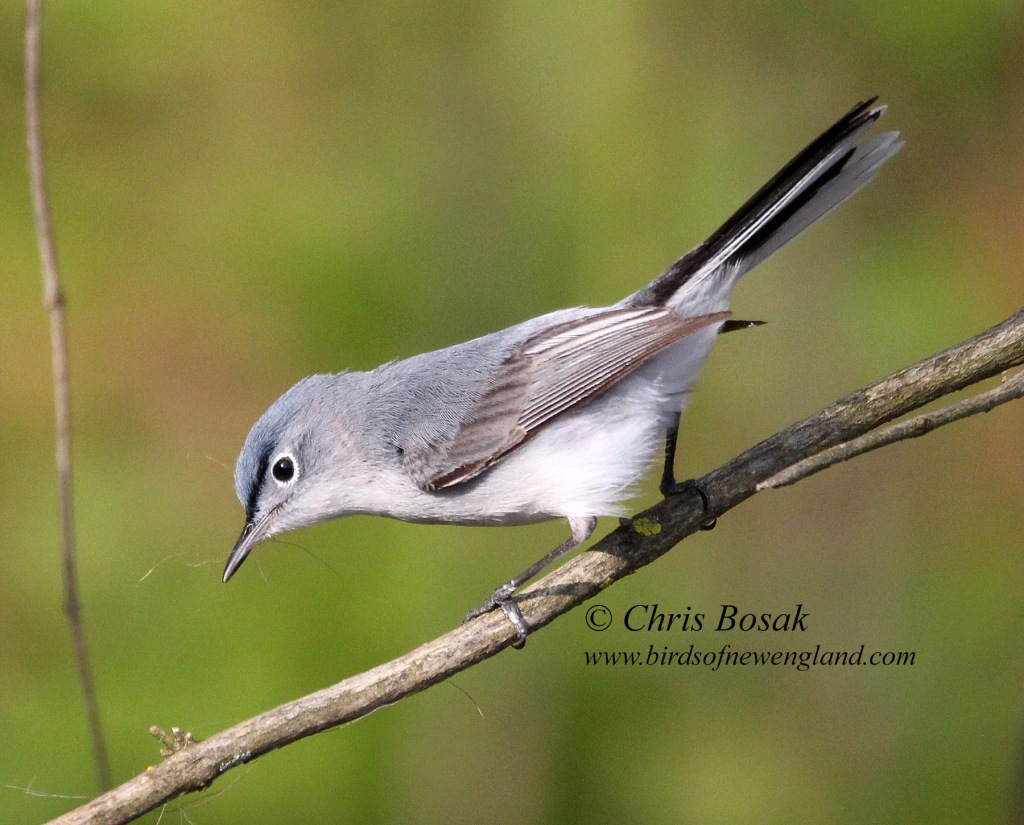
The birdwatching had already been fantastic as Baltimore orioles, gray catbirds, yellow warblers, and even bay-breasted warblers were overly abundant. The walk got even more exciting as we watched a blue-gray gnatcatcher fly back and forth from a branch to a bush about 30 yards away.
A nest must be up there, I thought, as we now watched two blue-gray gnatcatchers going back and forth to the branch. Blue-gray gnatcatchers are small migratory birds with blue-gray plumage, as the name suggests, long tail and white eye ring. A peek through the binoculars confirmed that a nest was on the branch. I was surprised that the nest had been built in the middle of a dead branch with very little cover from the leaves above.
It took binoculars for confirmation as blue-gray gnatcatchers are tiny birds of only four or five inches. Their nests are just as small as the birds themselves, even a bit smaller at only two or three inches wide.
The Cornell Lab of Ornithology describes the blue-gray gnatcatcher nest as such: “(It is) attached to its branch with spider webbing and decorated with lichen. The nest’s high walls are built in flexible layers. The main structural layer is built of fibrous materials like plant stems, bark strips, and grasses, all held together by spiderweb or caterpillar silk.”
Like some other birds, such as house wrens, blue-gray gnatcatchers often build “dummy” nests to throw off predators. Perhaps that explains why the nest was built in such an open area. Cornell says the multiple nests are also to “counteract the effects of predation, mite infestations, or cowbird parasitism.”
Speaking of cowbird parasitism, the eastern phoebes that nest at my work returned this year and built a nest in the same spot as the last two years. The first time I checked the nest this spring, I saw four eggs in the nest: three phoebe eggs and one cowbird egg. A week or so later, I checked again and, unfortunately, only the cowbird chick was in the nest. No other chicks, no other eggs.
I get mixed results when I do an internet search for whether it is appropriate to remove cowbird eggs. (Cowbirds are nest parasites and lay their eggs in the nests of other birds so the unsuspecting parents of the host nest raise cowbirds − often at the expense of their own offspring.) Aside from being illegal under the Migratory Bird Species Act, most experts agree that it is best to leave the eggs alone.
But back to that walk the other week. After watching the gnatcatchers for some time, I headed back on the same trail. I noticed a female yellow warbler remaining close to a low-growing shrubby tree on the right-hand side. The brush on either side of the trail was very thick and impenetrable. This shrubby tree, however, was at a point where it was accessible on either side of the tree. I gingerly walked up to the tree and spied a yellow warbler nest where one of the little branches met the trunk.
I had never found a nest of a blue-gray gnatcatcher or a yellow warbler before and I had found both in a matter of a half hour. Not a bad walk, for sure.
There was one more highlight to come on this walk and it also involved young birds. As we walked by the lake, I noticed a blob in a distant cove. I figured it was a duck, but I couldn’t tell what kind with the naked eye. Looking through the binoculars, I saw a female common merganser with about a dozen fluffy young ducks encircling her snuggled into her feathers.
The scene reminded me of the time I was canoeing in northern New Hampshire and saw a female common merganser swimming with a dozen little balls of fluff following behind her. To this day, it is one of my favorite photos I’ve taken.
Spring migration 2024 may be over, but there is still a lot of excitement out there in the birding world. Good luck to all the birds and birders.

Another interesting, informative article. Always enjoy the read. ☺️
LikeLiked by 1 person